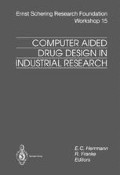Abstract
The early days of applied computational chemistry were characterized by two extreme attitudes, best represented by E. Clementi’ s enthusiastic statement in 1973 “We can calculate everything!” and C. Coulson’s reply “Give us insight not numbers!” A further decade was needed to convincingly demonstrate that computational methods can contribute significantly to real problems in organic chemistry. Theoretical methods now provide an invaluable tool to rationalize many aspects of chemical reactivity. As a consequence of the enormous developments in hardware and software, quantum mechanical calculations with a fairly high degree of sophistication can now be applied relatively easy even to series of medium-sized organic molecules such as steroids. For drug design the developments in computer graphics certainly played the decisive role to visualize molecular properties and to communicate theoretical results to the experimentalists. The potential of molecular modeling techniques as an inspiring tool to create new and unconventional ideas has now widely been recognized The contributions from computational chemistry can guide a drug finding process into areas of new (lead) structures. However, no one discipline ever produces a drug, so computational chemists cannot either. Among other areas such as synthetic chemistry, pharmacology, and biology, computational chemistry is one part of the interdisciplinary approach in the early stages of developing a drug.
Access this chapter
Tax calculation will be finalised at checkout
Purchases are for personal use only
Preview
Unable to display preview. Download preview PDF.
References
Alper J (1994) Drug discovery on the assembly line. Science 264: 1399–1401
Armstrong RA, Jones RL, MacDermot J, Wilson NH (1986) Prostaglandin en- doperoxide analogues which are both thromboxane receptor agonists and prostacyclin mimetics. Br J Pharmacol 87: 543–551
Deisenhofer J, Epp O, Miki K, Huber R, Michel H (1985) Structure of the protein subunits in the photosynthetic reaction centre of Rhodopseudomonas viridis at 3 A resolution. Nature 318: 618–624
Egner U, Hoyer G-A, Saenger W (1993) Modeling and energy minimization studies on the herbicide binding protein ( D1) in photosystem II of plants. Biochim Biophys Acta 1142: 106–114
Franke R (1984) Theoretical drug design methods. Elsevier, Amsterdam Gallop MA, Barrett RW, Dower WJ, Fodor SPA, Gordon EM (1994) Applica-tions of combinatorial technologies to drug discovery 1. Background and peptide combinatorial libraries. J Med Chem 37: 1233–1251
Gunsteren WF van, Berendsen HJC (1990) Computer simulation of molecular dynamics: methodology, applications, and perspectives in chemistry. Angew Chem Int Ed Eng129: 992–1023
Gunsteren WF van, Mark AE (1992) On the interpretation of biochemical data by molecular dynamics computer simulation. Eur J Biochem 204: 947–961
Gryglewski RJ, Stock G (eds) (1987) Prostacyclin and its stable analogue ilo-prost. Springer, Berlin Heidelberg New York
Johnson MA, Maggiora GM (eds) (1990) Concepts and applications of molecular similarity. Wiley, New York
Lybrand TP (1990) Computer simulation of biomolecular systems using molecular dynamics and free energy perturbation methods. In: Lipkowitz KB, Boyd DB (eds) Reviews in computational chemistry. VCH, New York, pp 295–320
Marshall GR, Barry CD, Bosshard HE, Dammkoehler RA, Dunn DA (1979) The conformational parameter in drug design: the active analog approach. In: Olson EC, Christoffersen RE (eds) Computer-assisted drug design ACS symposium series 112. Am Chem Soc, Washington DC, pp 205–226
Martin YC (1992) 3D database searching in drug design. J Am Chem Soc 35: 2146–2154
Merritt JE, Hallam TJ, Brown AM, Boyfield I, Cooper DG, Hickey DMB, Jaxa-Chamiec AA, Kaumann AJ, Keen M, Kelly E, Kozlowski U, Lynham JA, Moores KE, Murray KJ, MacDermot J, Rink TJ (1991) Octimibate, a potent non-prostanoid inhibitor of platelet aggregation, acts via the prostacyclin receptor. Br J Pharmacol 102: 251–259
Michel H, Epp O, Deisenhofer J (1986a) Pigment-protein interactions in the photosynthetic reaction center from Rhodopseudomonas viridis. EMBO J 5: 2445–2451
Michel H, Weyer KA, Gruenberg H, Dunger I, Oesterhelt D, Lottspeich F (1986b) The `light’ and `medium’ subunits of the photosynthetic reaction center from Rhodopseudomonas viridis: isolation of the genes, nucleotide and amino acid sequence. EMBO J 5: 1149–1158
Primas H, Müller-Herold U (1984) Elementare Quantenchemie Teubner, Stuttgart, p 289
Seiler S, Brassard CL, Arnold AJ, Meanwell NA, Fleming JS, Keely SL (1990) Octimibate inhibition of platelet aggregation: stimulation of adenylate cyclase through prostacyclin receptor activation. J Pharmacol Exp Ther 255: 1021–1026
Sheridan RP, Nilakantan R, Dixon JS, Venkataraghavan R (1986) The ensemble approach to distance geometry: application to the nicotinic pharmacophore. J Med Chem 29: 899–906
Sinning I, Michel H, Mathis P, Rutherford AW (1989) Terbutryn resistance in a purple bacterium can induce sensitivity toward the plant herbicide DCMU. FEBS Lett 256: 192–194
Skuballa W, Schäfer M (1989) Prostacyclin-Derivate. Nachr Chem Techn Lab 37: 584–590
Trebst A (1987) The three-dimensional structure of the herbicide binding niche on the reaction center polypeptides of photosystem II Z. Naturforsch 42c: 742–750
Verlinde CLMJ, Hol WGJ (1994) Structure-based drug design: progress, results and challenges. Structure 2: 577–587
Editor information
Editors and Affiliations
Rights and permissions
Copyright information
© 1995 Springer-Verlag Berlin Heidelberg
About this paper
Cite this paper
Eckle, E., Heinrich, N. (1995). Theoretical Chemistry as Part of the Interdisciplinary Approach to Rational Drug Design. In: Herrmann, E.C., Franke, R. (eds) Computer Aided Drug Design in Industrial Research. Ernst Schering Research Foundation Workshop, vol 15. Springer, Berlin, Heidelberg. https://doi.org/10.1007/978-3-662-03141-4_12
Download citation
DOI: https://doi.org/10.1007/978-3-662-03141-4_12
Publisher Name: Springer, Berlin, Heidelberg
Print ISBN: 978-3-662-03143-8
Online ISBN: 978-3-662-03141-4
eBook Packages: Springer Book Archive

